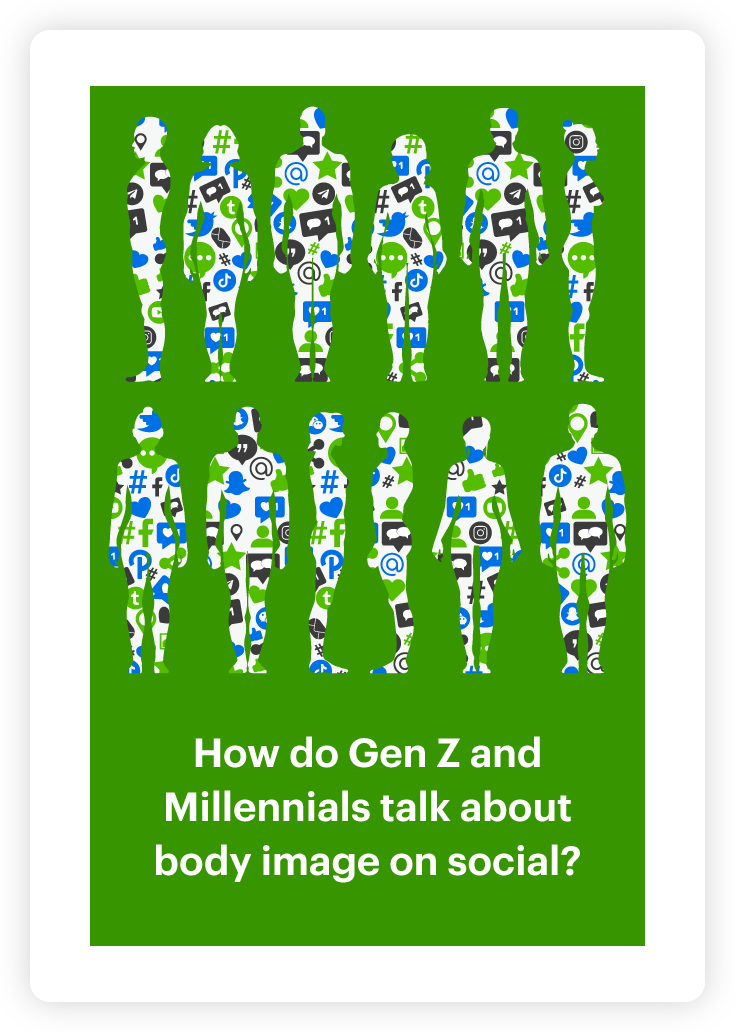Spider-Man: No Way Home audience analysis

The highly anticipated Spider-Man: No Way Home hit cinemas in December 2021. Generating much excitement, reviews of the film have flooded in thick and fast.
Being in the world of text analytics, we wanted to conduct a robust audience analysis for the latest Marvel film and dig deeper into Spider-Man: No Way Home reactions. In particular, we wanted to analyze the reactions of three distinct groups, who have different motivations to watch the film:
- Everyday movie goers – people who watched Spider-Man as a social activity
- Marvel fanatics – people who watched Spider-Man because of their love of Marvel comics and/or the wider film franchise
- Cinema enthusiasts – people with a keen interest in film; the self-proclaimed movie critics
To understand the unique audience characteristics of each group and various reactions to Spider-Man: No Way Home, we gathered audience data from Twitter (representing the everyday movie goer), Marvel fan forums (representing the Marvel fanatic) and IMDb reviews (representing the cinema enthusiast).
We then uploaded this data to Relative Insight, a text analytics platform with a comparative approach to audience insights analysis. Next, we compared the language used throughout these data sets, revealing the words, phrases, topics, emotions and grammar that are more prevalent in each group.
Everyday movie goers
Twitter data
Our audience analysis revealed that Twitter users were 3.8x more likely to talk about never having seen any Marvel film before Spider-Man: No Way Home. Using phrases such as never watched and first Marvel movie, it’s clear that the hype around the film coupled with effective marketing efforts has stimulated new audiences to see what the fuss is about.

In comparison to Marvel fans and IMDb reviewers, the general public on Twitter were much more likely to have an emotional response to the film. Viewers expressed feelings of happiness, sadness, fear and shock throughout their tweets, claiming to have cried three times and using words such as speechless to describe the film. Clearly, the emotional side of the film resonates with the everyday movie goer, who are deeply invested in the narrative.
Amongst everyday movie goers, there are some who have watched the latest Spider-Man more than once. This was evident in the language used on Twitter, with audiences 10.9x more likely to claim they are rewatching Spider-Man or going to see the film a second time. Film studios and entertainment companies are presented with an opportunity here – they could create marketing messaging specifically for film loyalists on social media. For example, creating targeted social ads insisting that the movie is so good, you have to see it twice.
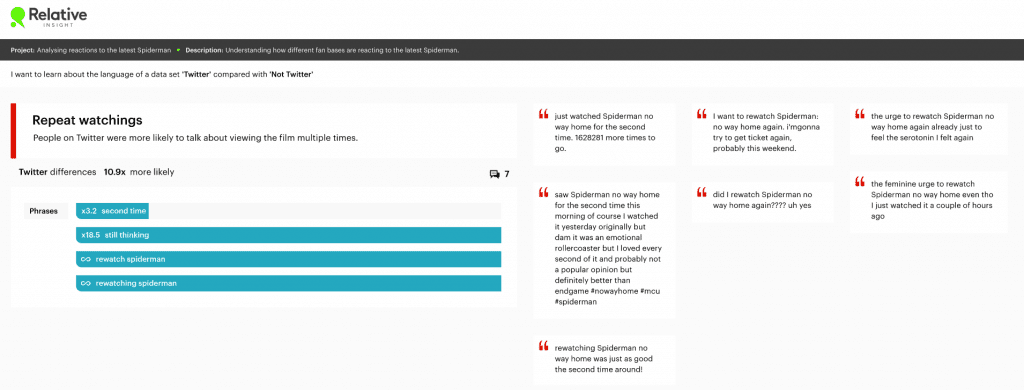
Marvel fanatics
Forum data
Looking specifically at Marvel forum data, we found that fans were 13.4x more likely to mention comics when discussing Spider-Man: No Way Home. Although Marvel fanatics compared the movie’s plot line to the original comics, debating its comic accuracy, they also observed that the film must be taken at face value. Audiences commented on the challenges of adapting any comic to the big screen, noting that “no one is replica to comics” and the film “might not be accurate to the comic, but I love [Holland’s] Peter Parker”.
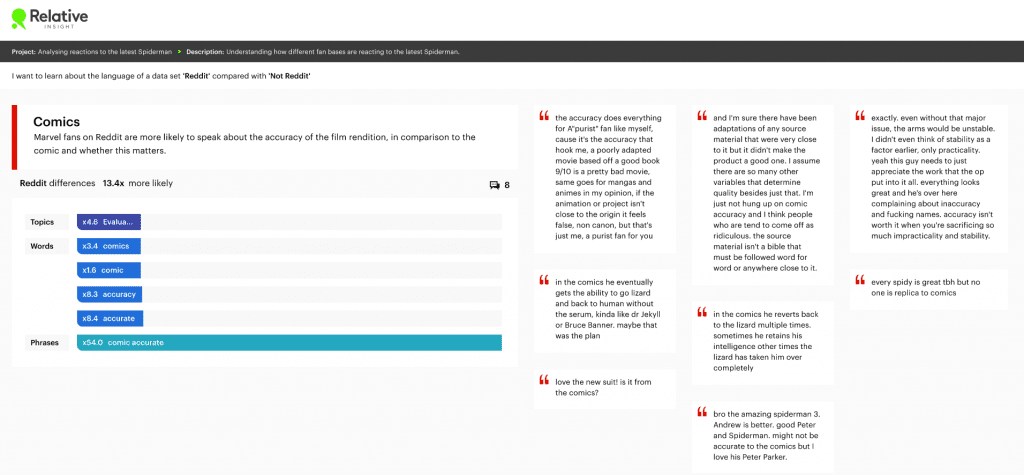
Spoiler alert!
Spider-Man: No Way Home is the first Marvel movie to combine various universes onscreen, with Tobey Maguire and Andrew Garfield’s Spider-Man joining Tom Holland in this third instalment. Several non-MCU characters from older films also make an appearance, including Green Goblin, Doctor Octopus and Electro.
What we found was that Marvel fans were 35.1x more likely to comment on the multiple universes at play in the film. Diehard Marvel fans have endless knowledge about the multiverse, which is explored throughout the comics. However, this is the first real time that the multiverse is depicted in one of the big Marvel movies. As viewers, we are unsure whether the latest Spider-Man is ushering in a new era of multiverse Marvel movies. However, the interesting point here is that the film has sparked conversation amongst Marvel fanatics, who have been waiting a long time to watch this be played out onscreen.
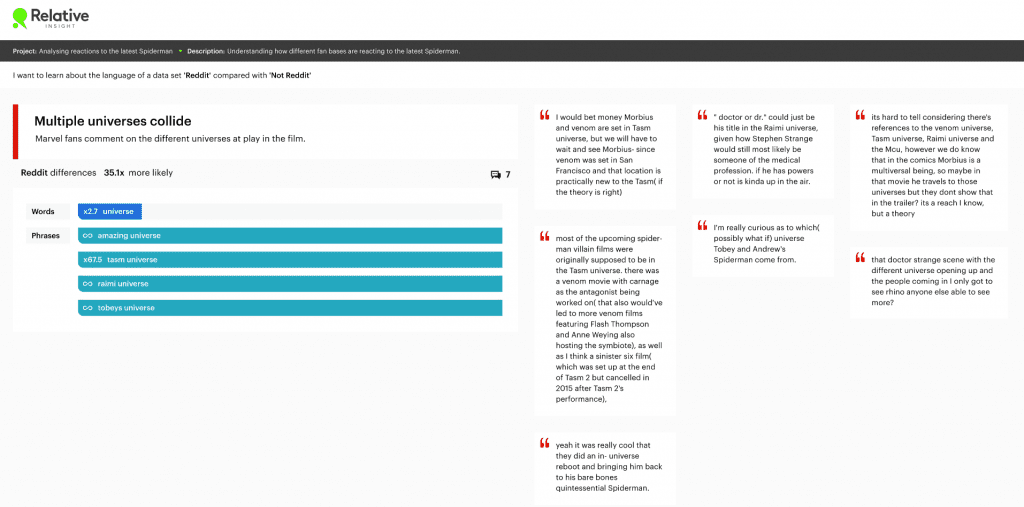
In contrast to everyday movie goers and cinema enthusiasts, Marvel forum users were 15.5x more likely to speak about Spider-Man’s suit and the technology throughout the film. This is a key difference that separates Marvel fanatics from other groups in this audience analysis. Rather than talking about their emotional response to the film or discussing specific cinematic moments, Marvel fans are interested in the geeky details.
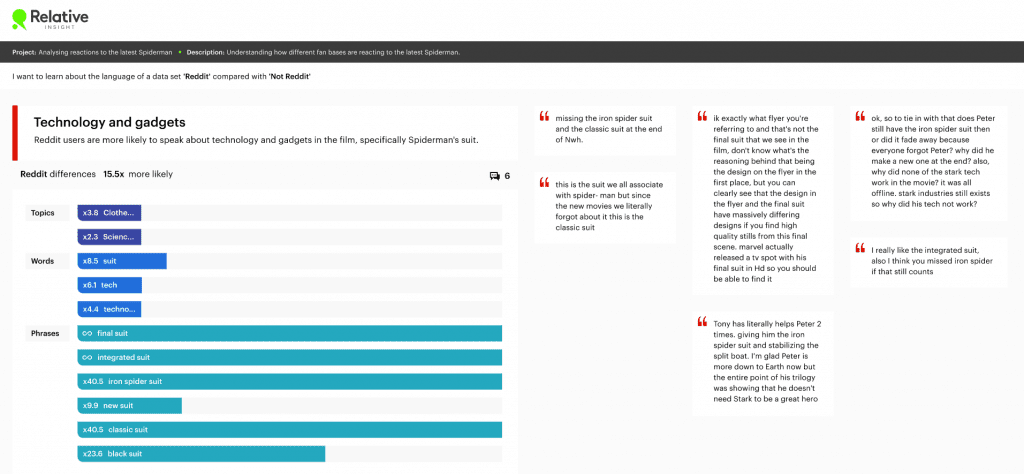
Cinema enthusiasts
IMDb reviews
Most IMDb reviews for Spider-Man: No Way Home came from people aged 30-44, giving us a glance into another demographic’s reactions to the film. What made this group unique was their attention to the art of filmmaking. These self-proclaimed critics were 25.9x more likely to comment on the cinematography, special effects, character development and action scenes in the latest Marvel hit, dissecting the movie into its various cinematic components.
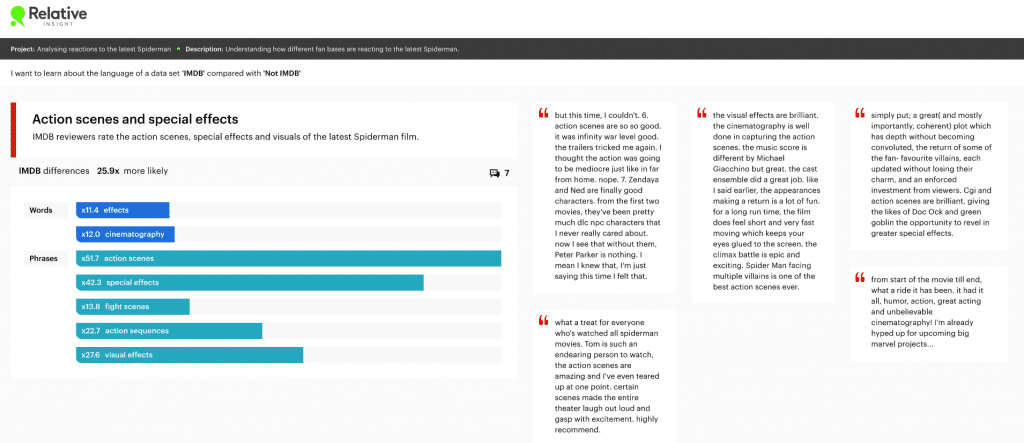
Similarly, we saw that IMDb reviewers unpicked the actors’ performance in the movie, as well as examining the onscreen chemistry between cast members. Clearly, this group of cinema enthusiasts position themselves as an authority when reviewing Spider-Man: No Way Home and show interest in the skills of those involved in the film: directors, producers, actors and cinematographers alike.
The phrase fan service stood out as linguistically important in this data set. Fan service is a term used in the entertainment industry to describe giving fans what they want in a narrative. IMDb reviewers addressed moments of fan service in the latest Spider-Man film, judging whether or not this is overdone. While fans might turn a blind eye to crowd-pleasing scenes, and the general public may remain innocently unaware, this insight highlights the objectivity of cinema enthusiasts, who are able to rate blockbuster, franchise films without bias.

Different channels attract different demographics. As this analysis shows, each audience group is varied in their reactions to Spider-Man: No Way Home. However, through comparison, we are able to understand the key differences in audience behaviour and characteristics.
This type of analysis can provide filmmakers and marketers with a glimpse into what motivates different demographics to watch a film, enabling them to deliver targeted communications to each segment and appeal to broader audiences.
Relative Insight is used by media and entertainment companies to better understand their audiences. Book a demo with one of our specialists to learn how they’re doing it.
